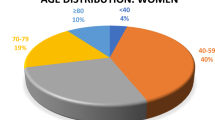Background:
Radiotherapy (RT) of nonmalignant diseases has a long-standing tradition in Germany. Over the past decade significant theoretical and clinical progress has been made in this field to be internationally recognized as an important segment of clinical RT. This development is reflected in a national patterns-of-care study (PCS) conducted during the years 2001–2002.
Material and Methods:
In 2001 and 2002, a questionnaire was mailed to all RT facilities in Germany to assess equipment, patient accrual, RT indications, and treatment concepts. 146 of 180 institutions (81%) returned all requested data: 23 university hospitals (UNI), 95 community hospitals (COM), and 28 private institutions (PRIV). The specific diseases treated at each institution and the RT concepts were analyzed for frequencies and ratios between the different institution types. All data were compared to the first PCS in 1994–1996.
Results:
In 137 institutions (94%) 415 megavoltage units (mean 1.7; range 1–4), and in 78 institutions (53%) 112 orthovoltage units (mean 1.1; range 0–2) were available. A mean of 37,410 patients were treated per year in all institutions: 503 (1.3%) for inflammatory disorders, 23,752 (63.5%) for degenerative, 1,252 (3.3%) for hypertrophic, and 11,051 (29.5%) for functional, other and unspecified disorders. In comparison to the first PCS there was a significant increase of patients per year (from 20,082 to 37,410; +86.3%) in most nonmalignant diseases during the past 7–8 years. Most disorders were treated in accordance with the national consensus guidelines: the prescribed dose concepts (single and total doses) varied much less during the period 2001–2002 in comparison with the previous PCS in 1994–1996. Only five institutions (3.4%) received recommendations to change single or total doses and/or treatment delivery. Univariate analysis detected significant institutional differences in the use of RT for various disorders.
Conclusion:
RT is increasingly accepted in Germany as a reasonable treatment option for many nonmalignant diseases. The long-term perspective and research plan will have to include various updates of PCS, rewriting of consensus guidelines, introduction of registries for rare nonmalignant disorders, and clinical controlled studies even for so-called established indications, as international acceptance is based on the criteria of evidence-based medicine.
Hintergrund:
Die Radiotherapie (RT) nichtmaligner Erkrankungen hat eine lange Tradition in Deutschland. Im letzten Jahrzehnt wurden theoretische und klinische Fortschritte gemacht, die diesem Bereich der RT auch international eine erhebliche Bedeutung verschafft haben. Die positive Entwicklung stützt die jüngste Patterns-of-Care-Studie (PCS) der Jahre 2001–2002.
Material und Methodik:
Im Jahr 2001 und 2002 wurden anhand eines Fragebogens an allen deutschen strahlentherapeutischen Institutionen die technische Ausstattung, Patientenzuweisung, Indikationen und RT-Konzepte bei nichtmalignen Erkrankungen erfasst. 146 von 180 Institutionen (81%) machten vollständige Angaben: 23 Universitätskliniken (UNI), 95 Versorgungskrankenhäuser (COM) und 28 private Praxen (PRIV). Die einzelnen Krankheitsgruppen und Erkrankungen pro Institution und die RT-Konzepte wurden nach Häufigkeit und Verhältnis zwischen den Institutionen analysiert und mit der ersten PCS aus den Jahren 1994–1996 verglichen.
Ergebnisse:
In 137 Institutionen (94%) standen 415 Megavolt-Geräte (Mittel 1,7; Spanne 1–4) und in 78 Institutionen (53%) 112 Orthovolt-Geräte (Mittel 1,1; Spanne 0–2) zur Verfügung. Im Mittel wurden insgesamt 37 410 Patienten pro Jahr behandelt: 503 (1,3%) wegen entzündlicher, 23 752 (63,5%) wegen degenerativer, 1 252 (3,3%) wegen hyperproliferativer und 11 051 (29,5%) wegen funktioneller, anderer und nicht spezifizierter Erkrankungen. Im Vergleich zur ersten PCS vor 7–8 Jahren stieg die Patientenzahl pro Jahr signifikant an (von 20 082 auf 37 410; +86,3%). Die meisten Erkrankungen wurden gemäß den nationalen Konsensus-Leitlinien behandelt: Die Dosierungskonzepte (Einzel- und Gesamtdosis) schwankten im Zeitabschnitt 2001–2002 weit weniger als bei der vorherigen PCS von 1994–1996. Nur fünf Institutionen (3,4%) wurde aufgrund der eingereichten Daten eine Änderung der Einzel- und Gesamtdosis oder der Bestrahlungstechnik empfohlen. Es fanden sich univariat statistisch signifikante Unterschiede zwischen den einzelnen Institutionen und Krankheitsgruppen.
Schlussfolgerung:
Die RT wird in Deutschland zunehmend als Behandlungsoption für viele nichtmaligne Erkrankungen akzeptiert. Die langfristige Perspektive und Forschung auf diesem Gebiet müssen neben der Aktualisierung von PCS auch die Überarbeitung der Konsensus-Leitlinien, die Einführung von Registern für seltene Erkrankungen und die Durchführung kontrollierter Studien auch bei „etablierten Indikationen“ zum Ziel haben, da die internationale Akzeptanz allein auf den Kriterien der evidenzbasierten Medizin aufbaut.
Similar content being viewed by others
Author information
Authors and Affiliations
Consortia
Corresponding author
Additional information
This paper is dedicated to Professor Rolf Sauer, MD, chair of the Department of Radiation Oncology, University of Erlangen, on the occasion of his 65th birthday.
Rights and permissions
About this article
Cite this article
Seegenschmiedt, M.H., Micke, O., Willich, N. et al. Radiation Therapy for Nonmalignant Diseases in Germany. Strahlenther Onkol 180, 718–730 (2004). https://doi.org/10.1007/s00066-004-9197-9
Issue Date:
DOI: https://doi.org/10.1007/s00066-004-9197-9
Key Words:
- Radiotherapy of nonmalignant diseases
- Patterns-of-care study
- Quality assurance
- Inflammatory/degenerative/hyperproliferative/functional disorders




